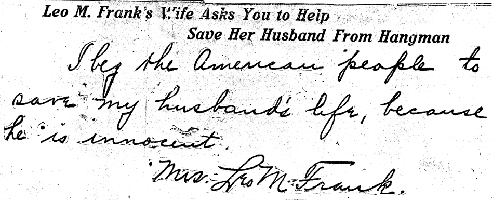
The True Story








Without Sanctuary
(Not about the Frank case per se, but a collection of the picture postcards that were taken of most lynchings. Leo Frank is mentioned several times on the site, and two pictures are in the collection. So you know, this site is VERY graphic, and will definatley upset you. Prepare yourself, and go take a look.)
The Lynchers of Leo Frank
(A partial list of the men who killed Leo Frank. Please keep in mind, these people are all dead, now, but their descendants are still living in Atlanta and Marietta. We cannot blame the people alive today for the sins of their great-grandfathers and grandfathers, but the people who committed this murder in 1915 shouldn't be able to hide behind an anonymous mob any longer. Basically, just don't blame the people alive today for something over which they had no control. That would be just as unfair as lynching a man for a murder he didn't commit.)
A Murder, A Lynching, A Mystery...
Politics, Prejudice, and Perjury
American Jewish Historical Society
Never Forget
The Mystery of the Pencil Factory
Cornell University Press
New York Times Article
The Atlanta
Journal and Constitution
Part One Part Two
(This article is not really a history, but told with an almost pulp fiction-ish glee. It's very clear who the author believes committed the murder- and as it was written in 1929, it would have been impossible for him to know for certain. He also makes several errors: He claims that Mary Phagan had blonde hair- she was a redhead- and that she had been raped. There is no evidence to the latter claim, but it is still a possibility. There was no way to be certain that Mary had been raped, and all of the "evidence" that did exist was circumstantial at best. Most likely, she was about to begin her menstrual cycle, and would have started bleeding later that day. That possibility covers all of the "evidence," and fits in better with the actual MO of the murder. Thought I'd share. Also, the author claims that Leo's body was found several hours after his murder. This also isn't true: the first onlookers came just as the lynchers were leaving. When they checked his body, they found a weak pulse, but left him up there until he was dead. Then they took pictures.)
(Leo's Alma Mater. I could forgive him almost anything, but he was a Cornell Grad. I graduated from Cornell's unofficial Sister College, Wells College, and I know what the Cornell boys think of us Wells Women, so as a rule I have to hate him. Nothing personal.)
(By Steve Oney, who will be publishing another book about the case in October of 2003.)
An interview with Mary Phagan Kean
(Mary Phagan's great-niece)
This is a really interesting article, offering the other side of the story. Ms. Kean is convinced that Leo Frank killed her great-aunt. Her evidence is interesting, but parts are flat-out wrong. My corrections...
1. She says that Leo Frank refused to be cross examined at the trial. I found it amazing, too, but PARADE was right: murder suspects were not permitted to take the stand in their own defense, they could only make sworn statements that could not be questioned by the prosecution. This practise has since changed, but at the time it was valid.
2. She says that the "murder notes" found by Mary Phagan's body could not have been written by a Southerner, because the notes used the word "Negro," and a Southerner would have said "Colored." Normally, this, too, would be correct, but Jim Conley, the African-American man whose testimony convicted Leo Frank, used the word "Negro" over and over in everyday speech and in pornographic notes written while in prison.
3. She says that there were no crowds yelling "Hang the Jew" outside the courthouse. She cites an Atlanta Constitution article as proof of this. I have only ever read one article that concurs with this statement, every other source notes the bellowing mobs outside. I wasn't there, I can't say for sure what it was like, but if she's right, then literally dozens of sources are wrong. I'm gonna go with the majority on this one.
Just so you go into the article knowing that she's mistaken on several points. As for the family history, I have no other sources on that, so she may be correct for all I know. Parts of it don't make sense- like young Mary's not attending school because there wasn't a desk for her- but may be possible. What little I do know, I have mentioned here.



Articles about the trial, verdict, and commutation, and lynching, respectively.